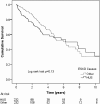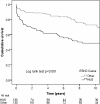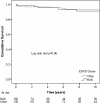End-stage kidney disease due to haemolytic uraemic syndrome--outcomes in 241 consecutive ANZDATA registry cases
- PMID: 23206870
- PMCID: PMC3544575
- DOI: 10.1186/1471-2369-13-164
End-stage kidney disease due to haemolytic uraemic syndrome--outcomes in 241 consecutive ANZDATA registry cases
Abstract
Background: The aim of this study was to investigate the characteristics and outcomes of patients receiving renal replacement therapy for end-stage kidney disease (ESKD) secondary to haemolytic uraemic syndrome (HUS).
Methods: The study included all patients with ESKD who commenced renal replacement therapy in Australia and New Zealand between 15/5/1963 and 31/12/2010, using data from the ANZDATA Registry. HUS ESKD patients were compared with matched controls with an alternative primary renal disease using propensity scores based on age, gender and treatment era.
Results: Of the 58422 patients included in the study, 241 (0.4%) had ESKD secondary to HUS. HUS ESKD was independently associated with younger age, female gender and European race. Compared with matched controls, HUS ESKD was not associated with mortality on renal replacement therapy (adjusted hazard ratio [HR] 1.14, 95% CI 0.87-1.50, p = 0.34) or dialysis (HR 1.34, 95% CI 0.93-1.93, p = 0.12), but did independently predict recovery of renal function (HR 54.01, 95% CI 1.45-11.1, p = 0.008). 130 (54%) HUS patients received 166 renal allografts. Overall renal allograft survival rates were significantly lower for patients with HUS ESKD at 1 year (73% vs 91%), 5 years (62% vs 85%) and 10 years (49% vs 73%). HUS ESKD was an independent predictor of renal allograft failure (HR 2.59, 95% CI 1.70-3.95, p < 0.001). Sixteen (12%) HUS patients experienced failure of 22 renal allografts due to recurrent HUS. HUS ESKD was not independently associated with the risk of death following renal transplantation (HR 0.92, 95% CI 0.35-2.44, p = 0.87).
Conclusions: HUS is an uncommon cause of ESKD, which is associated with comparable patient survival on dialysis, an increased probability of renal function recovery, comparable patient survival post-renal transplant and a heightened risk of renal transplant graft failure compared with matched ESKD controls.
Figures



Similar articles
-
End-stage kidney disease due to Alport syndrome: outcomes in 296 consecutive Australia and New Zealand Dialysis and Transplant Registry cases.Nephrol Dial Transplant. 2014 Dec;29(12):2277-86. doi: 10.1093/ndt/gfu254. Epub 2014 Jul 24. Nephrol Dial Transplant. 2014. PMID: 25061124
-
Long-term outcomes of end-stage kidney disease for patients with IgA nephropathy: A multi-centre registry study.Nephrology (Carlton). 2016 May;21(5):387-96. doi: 10.1111/nep.12629. Nephrology (Carlton). 2016. PMID: 26393772
-
End-Stage Kidney Disease Due to Fibrillary Glomerulonephritis and Immunotactoid Glomerulopathy - Outcomes in 66 Consecutive ANZDATA Registry Cases.Am J Nephrol. 2015;42(3):177-84. doi: 10.1159/000440815. Epub 2015 Sep 30. Am J Nephrol. 2015. PMID: 26418732
-
Atypical hemolytic uremic syndrome.Orphanet J Rare Dis. 2011 Sep 8;6:60. doi: 10.1186/1750-1172-6-60. Orphanet J Rare Dis. 2011. PMID: 21902819 Free PMC article. Review.
-
Heterogeneity of atypical haemolytic uraemic syndromes.Arch Dis Child. 1997 Jun;76(6):518-21. doi: 10.1136/adc.76.6.518. Arch Dis Child. 1997. PMID: 9245850 Free PMC article. Review.
Cited by
-
Changing Epidemiology and Outcomes of Hemolytic Uremic Syndrome in Children: A Prospective National Cohort Study from the Polish Pediatric HUS Registry and the Polish Registry of Renal Replacement Therapy in Children.J Clin Med. 2024 Oct 30;13(21):6499. doi: 10.3390/jcm13216499. J Clin Med. 2024. PMID: 39518638 Free PMC article.
-
Consequences of hemolytic uremic syndrome among hemodialysis patients.J Nephrol. 2015 Jun;28(3):361-7. doi: 10.1007/s40620-014-0149-x. Epub 2014 Dec 10. J Nephrol. 2015. PMID: 25491936 Free PMC article.
-
Haemolytic uremic syndrome as a cause of chronic kidney disease stage 5 in children is in retreat: results from the Polish Registry of Kidney Replacement Therapy in children (2000-2023).Pediatr Nephrol. 2025 Apr;40(4):1069-1079. doi: 10.1007/s00467-024-06584-2. Epub 2024 Nov 16. Pediatr Nephrol. 2025. PMID: 39549043 Free PMC article.
-
Characteristics and Outcomes of Renal Transplant Recipients with Hemolytic Uremic Syndrome in the United States.Transplant Direct. 2015 Nov;1(10):e41. doi: 10.1097/TXD.0000000000000555. Epub 2015 Nov 18. Transplant Direct. 2015. PMID: 26949736 Free PMC article.
References
-
- Begue R, Dennehy PH, Peter G. Hemolytic uremic syndrome associated with Streptococcus pneumoniae. N Engl J Med. 1991;325:133–134. - PubMed
-
- Besbas N, Karpman D, Landau D, Loirat C, Proesmans W, Remuzzi G, Rizzoni G, Taylor CM, de KN V, Zimmerhackl LB. A classification of hemolytic uremic syndrome and thrombotic thrombocytopenic purpura and related disorders. Kidney Int. 2006;70:423–431. - PubMed
Publication types
MeSH terms
LinkOut - more resources
Full Text Sources
Medical

